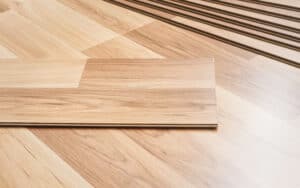
After being a homeowner for a while, you will likely start to see that most projects don’t go the way you expect them to go.
Chances are an issue or problem will come up at some point, and it will potentially decrease your desire to do things around the house.
However, over time, you will very likely start to learn more about what is involved in home improvement work, and you’ll pick up some tricks that can help you complete the projects easier.
One of those tricks is how to remove screws that will turn but won’t come out.
If you have run into this situation, don’t be concerned as there are simple tricks you can use to help get your project back on track.
Screw Turns but Won’t Come Out (How to Remove It)

The following steps will help you to remove a screw that is turning that won’t come out.
Step 1: Assess the Situation
The first step in this process is to take a look at what you are doing and see what might be causing the issue.
For the most part, the problem is that the screw is potentially older and needs to be replaced.
The older screws can sometimes be stripped, which causes their threads not to function anymore.
This means that the head of the screw is still working great, but the internal threads are just spinning.
In order to get this process started, take a look at the screw and the hole around it and see if you can see anything that could be blocking it from moving.
Most of the time, this is not the case, and you simply need to move on to the next step.
Step 2: Gather Materials
The tools that you will need for this project include a screwdriver, a flat head screwdriver, a utility knife, and sometimes a pair of gloves can also be helpful.
These tools will allow you to make sure that, once you get the screw freed from its spot, you can also start to pull it out.
Step 3: Pry
Once you have your materials, you can start to work on the process of actually getting the screw out.
Since the threads on the screw are no longer raised, and the wood around the screw is hollowed out, the screw simply continues to turn in place in the wood.
One of the best ways to get the screw onto a different path that may allow for it to be released from the wood is to use a flat head screwdriver to start prying the screw out.
You will place the tip of the flathead screwdriver directly under the head of the stripped screw.
Once the screwdriver is in place, try to pry up on the head of the screw a bit.
As you are prying up, you should then initiate the use of your traditional screwdriver and start turning it as you usually would.
Step 4: Pry and Turn
As you have the screw pushed up slightly from just under the head, you can turn the screwdriver to try and get it to move.
Sometimes this little bit of leverage is all it takes to get the screw into a position from which you can remove it from the hole it is in.
Sometimes when a screw is stripped, it is mainly causing a problem directly around the screw itself.
When it starts to move away from the same circular pattern it has been moving in, many times, this will be enough to release it from the hole.
As you pry and turn, don’t be afraid to keep pulling up on the underside of the screw head with the edge of the flat head screwdriver.
This should be all that is necessary to get the screw slightly removed from the hole.
Step 5: Manually Pull Screw When Possible
Once you have a good portion of the screw pulled out, chances are you can start to pull up on the screw with your fingers or pliers.
The pliers will help you grab onto the top of the screw and then pull at it.
If the screw is completely stripped, you might even be able to do this with your fingers.
Sometimes this method is faster and easier than just continuing to try and work with the screwdrivers.
Step 6: Replace Screw
Now that you have taken the screw out, you are going to want to replace it with a new screw.
Take a look into the hole and see if, in fact, the area is completely hollowed out.
Sometimes this happens, and it will require you to use a bit of wood filler when you replace the screw.
Adding the wood filler will only take a tiny extra step, but it could help to make sure that the screw does not get stuck again in the future.
You may also need to use a larger screw this time around so that there is more for it to grab onto inside the wood.
How to Remove a Stripped Screw Head

Now that you know what to do with a screw that turns but won’t come out, it’s a good idea to think about what happens when a screw head is not moveable.
Sometimes you will go to take a screw out, but the head of the screw is stripped.
This usually means that the top of the screw no longer has the indentations for you to insert the screwdriver.
If the indentations are there, it is possible that they are very smooth and not as raised or ready for you to use a screwdriver on them.
Sometimes this can be a more difficult issue to deal with than stripped screw threads.
The flat head screwdriver can get quite a bit of traction, and that is what helps to get the screw moving at times.
We like to try and go a size bigger than the size you need because this sometimes gives you just the amount of grip you need to get the screw moving.
If you can’t get it to work with the tool you have, you can use a screw extractor.
A screw extractor has a sharp, rough metal threaded tip.
The tip goes into the softer metal of the screw head, and it gives you enough grab to get the screw turning.
Once the screw is slightly removed from the wood or material that it is stuck in, you can then use pliers to continue turning it and pulling it out.
This process is not difficult to accomplish once you have the screw slightly away, and you can switch to those pliers.
Sometimes you can also use a drill to get the stuck screw released from its place, but if you don’t have one handy, it’s good to know a few different ways to complete this process.
How Not to Strip a Screw During Installation

Now that you know how to get a screw out, you want to make sure that you are not the one who was causing these issues to begin with.
Luckily, you can do some things to make sure that you don’t strip the screw as you are installing it into the material you are working with.
1. Drill a Pilot Hole
The drilling process is much easier on all those involved when there is a pilot hole.
The pilot hole helps to ensure that the screw has a place to go and that there is much less pressure on the screw as it travels through the material.
In the end, this ends up making it less likely for you to strip the screw or the screw head as you drill.
This is especially important when you are working with materials that are difficult to get through.
2. Use the Clutch
The clutch is your way of protecting and controlling how much force you are putting on the screw.
The clutch can be adjusted so that it does not allow too much force to be applied when resistance is met.
When you don’t use the clutch, the screw can just spin out of control, and it can get worn down and eventually stripped.
A clutch is a tool that tends to make a big difference in this process, and it should be used.
3. Use Enough Power
Don’t be afraid to squeeze the trigger in full and get your screw into place quickly.
Sometimes when you baby it a bit, the screw will slip out of place, and this will end up causing the screwdriver or drill to strip the top.
Once you have the screw in place, do not tighten it down too much.
This extra tightening can lead to the screw head being stripped as well as the threads of the screw itself.
Overall, as long as you are using the proper tools with the right pressure and safety precautions in place, you should not have any trouble with stripping a screw.



I’m still learning from you, as I’m trying to reach my goals. I certainly love reading all that is written on your website.Keep the information coming. I loved it!